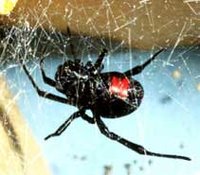Black widow spider
|
|
| Black Widow | ||||||||||||||
|---|---|---|---|---|---|---|---|---|---|---|---|---|---|---|
 Black Widow spider | ||||||||||||||
| Scientific classification | ||||||||||||||
| ||||||||||||||
| Binomial name | ||||||||||||||
| Latrodectus mactans Fabricius, 1775 |
The black widow spider (Latrodectus mactans) is notorious for its neurotoxic venom. It is a large widow spider found throughout the world and commonly associated with urban habitats or agricultural areas. Although the common name 'black widow spider' is used to refer specifically to L. mactans it is occasionally also applied to several members of the Latrodectus (widow spider) genus in which there are 31 recognised species including the Australian red-back and brown widow spider. In South Africa the black widow is known as the button spider.
Adult black widow spiders are shiny black with an hourglass shape marking on the bottom of its abdomen which, although most commonly red, may range in color from white to yellow to various shades of orange and red. In some varieties, the two halves of the hourglass shape may be separated into two separate dots. Female black widow spiders are about 1.5 inches (38 mm) counting legspan. The body is about 0.5 inches (13 mm). Male black widow spiders are half the size of the female, but with longer legs.
Venom components and effects
Though its venom is extremely potent, little of it is injected and deaths from Latrodectus bites are rare, only sixty-three having been reported in the United States between 1950 and 1959 (Miller, 1992). Black widow venom acts by causing a localized release of the neurotransmitter acetylcholine, which is involved in muscular contraction.
There are a number of active components in the venom. There are a few high-molecular mass components (These proteins, called latrotoxins, cause a massive transmitter release from a diversity of nerve endings); a number of smaller polypeptides, toxins interacting with cation channels which display spatial structure homology. They can affect the functioning of calcium, sodium, or potassium channels. There are also a few even more simple molecules, adenosine (1), guanosine (2), inosine (3), and 2,4,6-trihydroxypurine (4). The mechanism of the venom relates to the toxin initially being carried by the lymphatic system until it reaches the blood stream. Once in the blood, the toxin is moved by the circulation and deposited in the nerve ends where they insert into the muscle. Most strongly affected are back, abdomen, and thigh muscle areas. The venom acts at the nerve ends to prevent relaxation of the muscle, causing tetany - or constant, strong, painful contractions of the muscles. Standard treatments usually involve symptomatic therapy with pain medication, muscle relaxants, and, rarely, antivenin. The venom does not typically cause problems at the bite site itself, unless a secondary skin infection occurs.
Black widow spiders live in temperate and tropical zones (McCorkle, 2002). They typically prey on a variety of insects, but occasionally they do feed upon wood lice, diplopods, chilopods and other arachnids (McCorkle, 2002). When the prey is entangled by the web, L. mactans quickly comes out of its retreat, wraps the prey securely in its strong web, then punctures and poisons its prey (Foelix, 1982). The poison takes about ten minutes to take effect, meanwhile the prey is held tightly by the spider (Foelix, 1982). When movements of the prey cease, digestive enzymes are released into the wound (Foelix, 1982). The black widow spider then carries its prey back to its retreat before feeding (Foelix, 1982).
As is characteristic of all arthropods, black widow spiders have a hard exoskeleton composed of chitin and protein (5). When a male is mature, he spins a sperm web, deposits semen on it, and charges his palpi with the sperm (3). Black widow spiders reproduce sexually when the male inserts his palpus into the female's spermathecal openings (3). The females often kill and eat the male after mating; however, some males do escape under circumstances wherein the female is already well-fed (1). The female deposits her eggs in a globular silken container which they remain camouflaged and guarded (3). A female black widow spider can produce nine egg sacs in one summer, each containing about 400 eggs (1). Usually, eggs incubate for twenty to thirty days, but rarely do more than twelve survive through this process, due to cannibalism (1). It takes two to four months for black widow spiders to mature. The female live on for 180 days after maturing, while a male only lives on for another ninety days (1).
According to a widely-reported media story (Wigmore, 2003), Chilean scientists were using part of Latrodectus venom to synthesize a drug that will not only serve as a male contraceptive, but will also work in a fashion similar to Viagra; however, this has not been reported in any mainstream peer-reviewed scientific journal.

